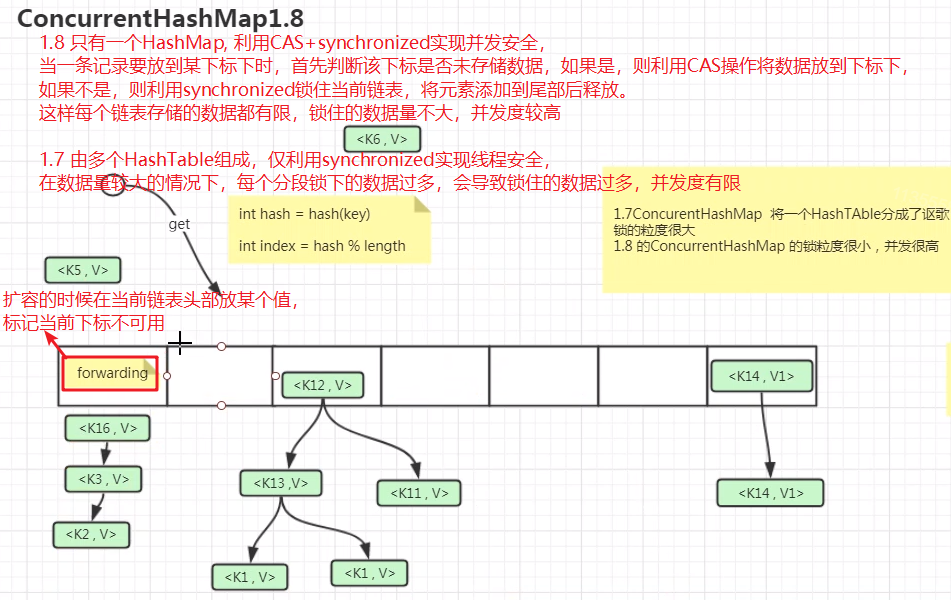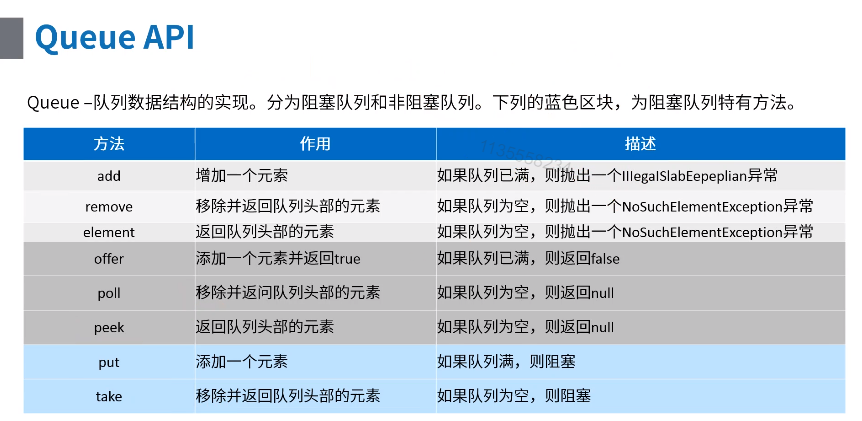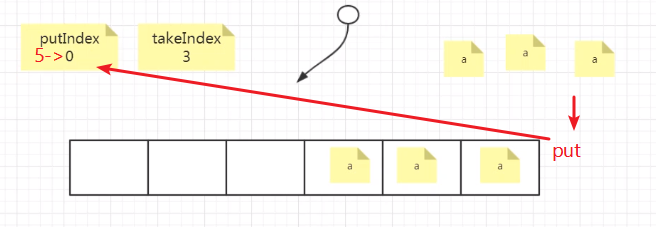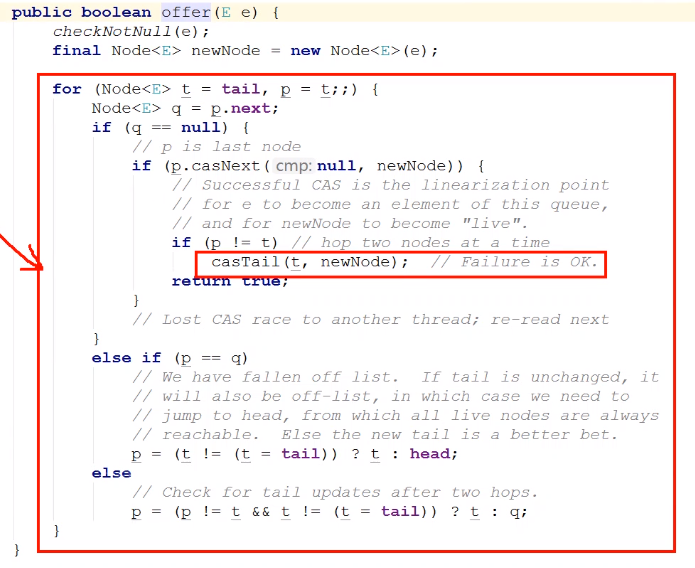HashMap
下标计算方法:hashCode & (length-1) ,&按位与操作,二进制相同位都是1,该位才为1
JDK1.7与JDK1.8中HashMap区别: JDK1.8在put元素时,若计算得到的下标下的链表长度达到8时(算上当前要加到链表尾部的元素),链表会转换成红黑树提高查找效率
ConcurrentHashMap
线程安全的HashMap
JDK1.7 ConcurrentHashMap有多个HashTable组成,有几个HashTable并发级别concurrencyLevel就是几,默认16,这就叫分段锁,




ConcurrentSkipListMap/TreeMap
TreeMap与HashMap不同之处在于,TreeMap按照key的字典顺序来排序(升序),也可通过Comparator实现排序逻辑
TreeMap线程不安全,使用ConcurrentSkipListMap保证线程安全


ArrayList
非线程安全
CopyOnWriteArrayList
线程安全,
但会对数组进行拷贝,在某段时间数据量翻倍造成内存溢出,不适用数据量过大的情况
读取新写入的数据会有延迟,因为数组的引用需要从旧数组转到新数组
HashSet
HashMap如果遇到相同的Key会对Value值进行覆盖,保证HashMap的Key是不重复的。
HashSet<T> 即利用HashMap这一特性保证Set集合中元素(KEY)不重复,其并不关心Value的值。
CopyOnWriteArraySet
写的时候会判断数组中是否已经存在,若存在就不再写入,其他特性与CopyOnWriteArrayList相同
ConcurrentSkipListSet
跳表实现原理同ConcurrentSkipListMap,KEY不重复且有序
队列QUEUE

ArrayBlockingQueue
线程安全,数组实现,ReentrantLock锁,只有一把锁,take() 和 put() 互斥,加的是同一把锁;
构造函数制定队列长度capacity,利用参数count记录队列中元素数量,count=capacity时put操作阻塞,count=0时take操作阻塞,底层唤醒其实是利用condition的2个队列实现,参照1.3.1 Lock利用condition实现的阻塞队列;
put和take时利用takeIndex和putIndex记录下一个操作应该放到那个位置或从哪个位置取;
循环数组实现:当putIndex达到capacity时,takeIndex并不是+1,而是变成0,即下一个put操作会将元素放到队列头部;takeIndex原理相同

LinkedBlockingQueue
线程安全,链表实现,有读锁和写锁2把锁,读和写操作加的是不同的锁,互不干扰,提高了读写性能
ConcurrentLinkedQueue
线程安全,并发度高,非阻塞队列,无锁,没有take() 和 put()这2个阻塞方法
利用CAS操作,采用自旋的方式将元素添加到链表尾部 或 将链表头部替换为null


SynchronousQueue
不常用
package com.study.list_set_queue.queue;
import java.util.concurrent.SynchronousQueue;
/*
1、take会阻塞,直到取到元素
2、put时会阻塞,直到被get
3、若没有take方法阻塞等待,offer的元素可能会丢失
4、poll取不到元素,就返回null,如果正好有put被阻塞,可以取到
5、peek 永远只能取到null,不能让take结束阻塞
*/
public class Demo2_SyncQueueTest {
static SynchronousQueue<String> syncQueue = new SynchronousQueue<>();
//put时会阻塞,直到被get
public static void test01() throws InterruptedException {
new Thread(){
@Override
public void run() {
try {
Thread.sleep(3000L);
System.out.println(syncQueue.poll());
} catch (InterruptedException e) {
e.printStackTrace();
}
}
}.start();
System.out.println("begain to put...");
syncQueue.put("put_element");
System.out.println("put done...");
}
//3、若没有take方法阻塞等待,offer的元素可能会丢失
public static void test02() throws InterruptedException {
syncQueue.offer("offered_element");
System.out.println(syncQueue.poll());
}
//4、poll取不到元素,就返回null,如果正好有put被阻塞,可以取到
public static void test03() throws InterruptedException {
/* new Thread(){
@Override
public void run() {
try {
syncQueue.put("put_element");
} catch (InterruptedException e) {
e.printStackTrace();
}
}
}.start();*/
Thread.sleep(200L);
Object obj = syncQueue.poll();
System.out.println(obj);
}
//peek 永远只能取到null,不能让take结束阻塞
public static void test04() throws InterruptedException {
new Thread(){
@Override
public void run() {
try {
syncQueue.put("put_element");
} catch (InterruptedException e) {
e.printStackTrace();
}
}
}.start();
Thread.sleep(200L);
Object obj = syncQueue.peek();
System.out.println(obj);
}
public static void main(String args[]) throws InterruptedException {
test02();
}
}
PriorityBlockingQueue
优先级队列,可以通过比较器对入队列的元素进行排序存储,进而改变出队列顺序
package com.study.list_set_queue.queue;
import java.util.Comparator;
import java.util.concurrent.PriorityBlockingQueue;
public class Demo4_PriorityBlockingQueue3 {
public static void main(String args[]) {
PriorityBlockingQueue<Student> queue = new PriorityBlockingQueue<>(5, new Comparator<Student>() {
@Override
public int compare(Student o1, Student o2) {
int num1 = o1.age;
int num2 = o2.age;
if (num1 > num2)
return 1;
else if (num1 == num2)
return 0;
else
return -1;
}
});
queue.put(new Student(10, "enmily"));
queue.put(new Student(20, "Tony"));
queue.put(new Student(5, "baby"));
for (; queue.size() > 0;) {
try {
System.out.println(queue.take().name);
} catch (InterruptedException e) {
e.printStackTrace();
}
}
}
}
class Student {
public int age;
public String name;
public Student(int age, String name) {
this.age = age;
this.name = name;
}
}

